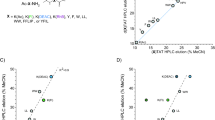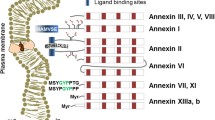ABSTRACT
Purpose
Efficient delivery of therapeutic biopolymers across cell membranes remains a daunting challenge. The development of cell-penetrating peptides (CPPs) has been useful; however, many CPPs are found trapped within endosomes, limiting their use as delivery agents. We optimize a class of CPPs, cationic amphiphilic polyproline helices (CAPHs), for direct transport into cells with mitochondrial localization through dimerization.
Methods
The CAPH P11LRR used for this study has been found to enter cells by two distinct pathways: an endocytotic pathway was favored at low concentrations; internalization by direct transport was observed at higher concentrations. CAPH was dimerized to probe if direct transport within cells may be enhanced through increased association of CAPH with the membrane and through the association of individual peptides within the membrane.
Results
The dimerization of the CAPH was found to significantly increase cellular uptake over its monomeric counterpart, with a concomitant lowering of the concentration threshold favoring direct transport. Evidence for direct transport within cells and mitochondrial localization was observed.
Conclusions
CAPH cellular uptake efficiency can be significantly enhanced through peptide dimerization while favoring cell entry via direct transport at low concentration with low cell toxicity.








Similar content being viewed by others
Abbreviations
- CAPH:
-
cationic amphiphilic polyproline helix
- CPP:
-
cell-penetrating peptide
- FBS:
-
fetal bovine serum
- FCCP:
-
carbonylcyanide p-trifluoromethoxyphenylhydrazone
- FL:
-
fluorescein
- Fmoc:
-
9-fluorenylmethyloxycarbonyl
- HATU:
-
N,N,N',N'-Tetramethyl-O-(7-azabenzotriazol-1-yl)uranium hexafluorophosphate
- MTT:
-
3-(4,5-dimethylthiazol-2-yl)-2,5-diphenyltetrazolium bromide
- NHS-FL:
-
5-(and 6)-carboxyfluorescein, succinimidyl ester
- PBS:
-
phosphate-buffered saline
REFERENCES
Stewart KM, Horton KL, Kelley SO. Cell-penetrating peptides as delivery vehicles for biology and medicine. Org Biomol Chem. 2008;6(13):2242–55.
Fillon YA, Anderson JP, Chmielewski J. Cell penetrating agents based on a polyproline helix scaffold. J Am Chem Soc. 2005;127(33):11798–803.
Potocky TB, Menon AK, Gellman SH. Effects of conformational stability and geometry of guanidinium display on cell entry by beta-peptides. J Am Chem Soc. 2005;127(11):3686–7.
Geisler I, Chmielewski J. Cationic amphiphilic polyproline helices: side-chain variations and cell-specific internalization. Chem Biol Drug Des. 2009;73(1):39–45.
Derossi D, Calvet S, Trembleau A, Brunissen A, Chassaing G, Prochiantz A. Cell internalization of the third helix of the Antennapedia homeodomain is receptor-independent. J Biol Chem. 1996;271(30):18188–93.
Morris MC, Depollier J, Mery J, Heitz F, Divita G. A peptide carrier for the delivery of biologically active proteins into mammalian cells. Nat Biotechnol. 2001;19(12):1173–6.
Pujals S, Fernandez-Carneado J, Lopez-Iglesias C, Kogan MJ, Giralt E. Mechanistic aspects of CPP-mediated intracellular drug delivery: relevance of CPP self-assembly. Biochim Biophys Acta. 2006;1758(3):264–79.
Fischer PM, Zhelev NZ, Wang S, Melville JE, Fahraeus R, Lane DP. Structure-activity relationship of truncated and substituted analogues of the intracellular delivery vector Penetratin. J Pept Res. 2000;55(2):163–72.
Morris MC, Vidal P, Chaloin L, Heitz F, Divita G. A new peptide vector for efficient delivery of oligonucleotides into mammalian cells. Nucleic Acids Res. 1997;25(14):2730–6.
Pujals S, Fernandez-Carneado J, Ludevid MD, Giralt E. D-SAP: a new, noncytotoxic, and fully protease resistant cell-penetrating peptide. ChemMedChem. 2008;3(2):296–301.
Jones S, Martel C, Belzacq-Casagrande AS, Brenner C, Howl J. Mitoparan and target-selective chimeric analogues: membrane translocation and intracellular redistribution induces mitochondrial apoptosis. Biochim Biophys Acta. 2008;1783(5):849–63.
Li L, Geisler I, Chmielewski J, Cheng JX. Cationic amphiphilic polyproline helix P11LRR targets intracellular mitochondria. J Control Release. 2009;142(2):259–66.
Snyder EL, Dowdy SF. Cell penetrating peptides in drug delivery. Pharm Res. 2004;21(3):389–93.
Lewin M, Carlesso N, Tung CH, Tang XW, Cory D, Scadden DT, et al. Tat peptide-derivatized magnetic nanoparticles allow in vivo tracking and recovery of progenitor cells. Nat Biotechnol. 2000;18(4):410–4.
Lundberg P, Langel U. A brief introduction to cell-penetrating peptides. J Mol Recognit. 2003;16(5):227–33.
Lindgren M, Hallbrink M, Prochiantz A, Langel U. Cell-penetrating peptides. Trends Pharmacol Sci. 2000;21(3):99–103.
Ragin AD, Morgan RA, Chmielewski J. Cellular import mediated by nuclear localization signal Peptide sequences. Chem Biol. 2002;9(8):943–8.
Rothbard JB, Garlington S, Lin Q, Kirschberg T, Kreider E, McGrane PL, et al. Conjugation of arginine oligomers to cyclosporin A facilitates topical delivery and inhibition of inflammation. Nat Med. 2000;6(11):1253–7.
Umezawa N, Gelman MA, Haigis MC, Raines RT, Gellman SH. Translocation of a beta-peptide across cell membranes. J Am Chem Soc. 2002;124(3):368–9.
Wender PA, Mitchell DJ, Pattabiraman K, Pelkey ET, Steinman L, Rothbard JB. The design, synthesis, and evaluation of molecules that enable or enhance cellular uptake: peptoid molecular transporters. Proc Natl Acad Sci U S A. 2000;97(24):13003–8.
Singh D, Kiarash R, Kawamura K, LaCasse EC, Gariepy J. Penetration and intracellular routing of nucleus-directed peptide-based shuttles (loligomers) in eukaryotic cells. Biochemistry. 1998;37(17):5798–809.
Wender PA, Rothbard JB, Jessop TC, Kreider EL, Wylie BL. Oligocarbamate molecular transporters: design, synthesis, and biological evaluation of a new class of transporters for drug delivery. J Am Chem Soc. 2002;124(45):13382–3.
Zhou P, Wang M, Du L, Fisher GW, Waggoner A, Ly DH. Novel binding and efficient cellular uptake of guanidine-based peptide nucleic acids (GPNA). J Am Chem Soc. 2003;125(23):6878–9.
Geisler I, Chmielewski J. Probing length effects and mechanism of cell penetrating agents mounted on a polyproline helix scaffold. Bioorg Med Chem Lett. 2007;17(10):2765–8.
Farrera-Sinfreu J, Giralt E, Castel S, Albericio F, Royo M. Cell-penetrating cis-gamma-amino-l-proline-derived peptides. J Am Chem Soc. 2005;127(26):9459–68.
Torchilin VP. Tat peptide-mediated intracellular delivery of pharmaceutical nanocarriers. Adv Drug Deliv Rev. 2008;60(4–5):548–58.
Gazit E, Lee WJ, Brey PT, Shai Y. Mode of action of the antibacterial cecropin B2: a spectrofluorometric study. Biochemistry. 1994;33(35):10681–92.
Matsuzaki K, Murase O, Fujii N, Miyajima K. An antimicrobial peptide, magainin 2, induced rapid flip-flop of phospholipids coupled with pore formation and peptide translocation. Biochemistry. 1996;35(35):11361–8.
Horobin RW, Trapp S, Weissig V. Mitochondriotropics: a review of their mode of action, and their applications for drug and DNA delivery to mammalian mitochondria. J Control Release. 2007;121(3):125–36.
Maiti KK, Lee WS, Takeuchi T, Watkins C, Fretz M, Kim DC, et al. Guanidine-containing molecular transporters: sorbitol-based transporters show high intracellular selectivity toward mitochondria. Angew Chem Int Ed Engl. 2007;46(31):5880–4.
Fernandez-Carneado J, Van Gool M, Martos V, Castel S, Prados P, de Mendoza J, et al. Highly efficient, nonpeptidic oligoguanidinium vectors that selectively internalize into mitochondria. J Am Chem Soc. 2005;127(3):869–74.
Rosania GR. Supertargeted chemistry: identifying relationships between molecular structures and their sub-cellular distribution. Curr Top Med Chem. 2003;3(6):659–85.
Rosania GR, Lee JW, Ding L, Yoon HS, Chang YT. Combinatorial approach to organelle-targeted fluorescent library based on the styryl scaffold. J Am Chem Soc. 2003;125(5):1130–1.
Johnson JR, Jiang H, Smith BD. Zinc(II)-coordinated oligotyrosine: a new class of cell penetrating peptide. Bioconjug Chem. 2008;19(5):1033–9.
Rudolph C, Plank C, Lausier J, Schillinger U, Muller RH, Rosenecker J. Oligomers of the arginine-rich motif of the HIV-1 TAT protein are capable of transferring plasmid DNA into cells. J Biol Chem. 2003;278(13):11411–8.
Park SH, Doh J, Park SI, Lim JY, Kim SM, Youn JI, et al. Branched oligomerization of cell-permeable peptides markedly enhances the transduction efficiency of adenovirus into mesenchymal stem cells. Gene Ther. 2010;17(8):1052–61.
Kawamura KS, Sung M, Bolewska-Pedyczak E, Gariepy J. Probing the impact of valency on the routing of arginine-rich peptides into eukaryotic cells. Biochemistry. 2006;45(4):1116–27.
Nishihara M, Perret F, Takeuchi T, Futaki S, Lazar AN, Coleman AW, et al. Arginine magic with new counterions up the sleeve. Org Biomol Chem. 2005;3(9):1659–69.
Brogden KA. Antimicrobial peptides: pore formers or metabolic inhibitors in bacteria? Nat Rev Microbiol. 2005;3(3):238–50.
Mitchell DJ, Kim DT, Steinman L, Fathman CG, Rothbard JB. Polyarginine enters cells more efficiently than other polycationic homopolymers. J Pept Res. 2000;56(5):318–25.
Yamashiro DJ, Maxfield FR. Acidification of morphologically distinct endosomes in mutant and wild-type Chinese hamster ovary cells. J Cell Biol. 1987;105(6 Pt 1):2723–33.
Magzoub M, Pramanik A, Graslund A. Modeling the endosomal escape of cell-penetrating peptides: transmembrane pH gradient driven translocation across phospholipid bilayers. Biochemistry. 2005;44(45):14890–7.
Horton KL, Stewart KM, Fonseca SB, Guo Q, Kelley SO. Mitochondria-penetrating peptides. Chem Biol. 2008;15(4):375–82.
Di Virgilio F, Lew PD, Andersson T, Pozzan T. Plasma membrane potential modulates chemotactic peptide-stimulated cytosolic free Ca2+ changes in human neutrophils. J Biol Chem. 1987;262(10):4574–9.
Ross MF, Da Ros T, Blaikie FH, Prime TA, Porteous CM, Severina II, et al. Accumulation of lipophilic dications by mitochondria and cells. Biochem J. 2006;400(1):199–208.
Author information
Authors and Affiliations
Corresponding author
Electronic supplementary material
Below is the link to the electronic supplementary material.
ESM 1
(DOCX 245 kb)
Rights and permissions
About this article
Cite this article
Geisler, I.M., Chmielewski, J. Dimeric Cationic Amphiphilic Polyproline Helices for Mitochondrial Targeting. Pharm Res 28, 2797–2807 (2011). https://doi.org/10.1007/s11095-011-0493-7
Received:
Accepted:
Published:
Issue Date:
DOI: https://doi.org/10.1007/s11095-011-0493-7




